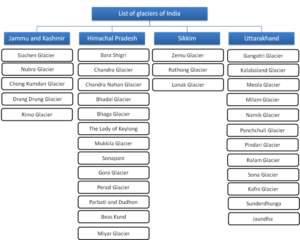In news- A recent study conducted by the Wadia Institute of Himalayan Geology (WIHG), Dehradun, an autonomous institute under the Department of Science & Technology has attributed the retreat of Pensilungpa Glacier in Ladakh to an increase in the temperature and decrease in precipitation during winters.
Key findings of the study-
- It is based on field observations for glacier mass balance collected via stake networking (stake made of bamboo, is installed (insert) on the glacier surface using the steam drill for mass balance measurement) over the glacier surface since 2016-2019.
- It has found that recessional trends of the Pensilungpa Glacier lead to an increase in the temperature and decrease in precipitation during winters.
- The mass balance data for the last 3 years (2016–2019) showed a negative trend with a small accumulation area ratio.
- The study also suggests that due to continuous rise in the air temperature in line with the global trend, the melting would increase.
- As per the study, it is possible that the precipitation of summer periods at higher altitudes will change from snow to rain, and that may influence the summer and winter pattern.
About Pensilungpa Glacier-
- It is located at the north western corner of Zanskar valley , Ladakh.
- Major part of the ablation zone of the glacier is debris covered.
- From the snout of this glacier river Suru originated.
- The glacier falls in the monsoon-arid transition zone.















